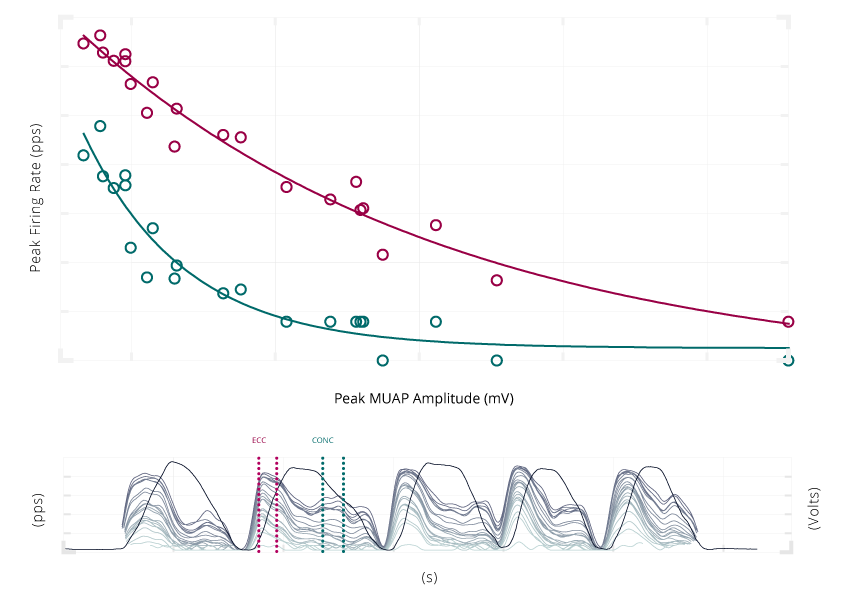Human Performance in Athletic
Objective: Assess and monitor changes in motor unit control of concentric and eccentric contractions during strength training repetitions in upper-limb curls.

Results
Motor unit data revealed specific modulations in the strength of motor unit activation – measured by calculating the mean firing rate curves of each motor units indicating the number of firing per seconds of each motor unit – during each repetition and within repetitions.
The peak activation of all motor units (shown for one specific repetition on the left side) was lower during the eccentric vs. concentric phase.
Other References
Sterczala et al. Differences in the motor unit firing rates and amplitudes in relation to recruitment thresholds during submaximal contractions of the first dorsal interosseous between chronically resistance trained and physically active men. App Physiol Nutr Metab 2018.
Hight et al. Adaptations in antagonist co-activation: Role in the repeated-bout effect. PLoS One 2017.
Contessa et al. The compensatory interaction between motor unit firing behavior and muscle force during fatigue. J Neurophysiol 2016.
Ye et al. Influence of prolonged static stretching on motor unit firing properties. Muscle Nerve 2015.
McManus et al. Changes in motor unit behavior following isometric fatigue of the first dorsal interosseous muscle. J Neurophysiol 2015.
Ye et al. Acute effects of dynamic exercises on the relationship between the motor unit firing rate and the recruitment threshold. Hum Mov Sci 2015.
Ye et al. Acute effects of concentric vs. eccentric exercise on force steadiness and electromyographic responses of the forearm flexors. J Strength Cond Res 2015.
Ye et al. Influences of dynamic exercise on force steadiness and common drive. J Musculoskel Neuronal Int 2014.
Stock & Thompson. Effects of barbell deadlift training on submaximal motor unit firing rates for the Vastus Lateralis and Rectus Femoris. PLoS ONE 2014.
Stock et al. Effects of fatigue on motor unit firing rate versus recruitment threshold relationship. Muscle Nerve 2012.
Beck et al. Eccentric exercise does not affect common drive in the biceps brachii. Muscle Nerve 2012.
Beck et al. Effects of fatigue on intermuscular common drive to the quadriceps femoris. Int J Neurosci 2012
Beck et al. Effects of resistance training on force steadiness and common drive. Muscle Nerve 2011.
Beck et al. The Effects of a Resistance Training Program on Average Motor Unit Firing Rates. Clin Kinesiol 2011.

